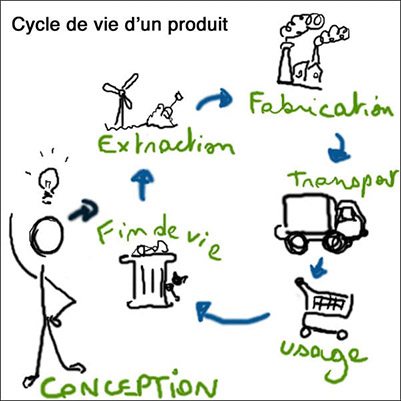Everyone’s looking for energy efficiency – in our cars, in our appliances and in our computers. But the often-neglected metric, the one we really need to pay attention to, is the embedded energy – the energy used to create a product in the first place.
To broaden our thinking, I find the accompanying image by Damaris Basile Judith extremely helpful. “Cycle de vie d’un produit” is “Lifecycle of a Product;” “Fin de vie” is “End of Life.” (Attribution: CC BY-SA 3.0 , via Wikimedia)
 To get the true picture of embedded energy, we need to think about the energy used in the extraction of the raw materials including the energy needed to refine extracted materials to a useable form, the energy used in the fabrication (manufacturing) of the product, and the energy needed to transport a product to where it is ultimately used.
To get the true picture of embedded energy, we need to think about the energy used in the extraction of the raw materials including the energy needed to refine extracted materials to a useable form, the energy used in the fabrication (manufacturing) of the product, and the energy needed to transport a product to where it is ultimately used.
How much energy does it take to make a computer? In the case of the life of a laptop computer, for example, the embedded energy is estimated to include as much as 85% of the total energy of the entire product’s lifecycle, considering just the manufacturing stage alone.
To expand the value from that initial expenditure of both energy and materials, the usage or “use” phase of the lifecycle has to expand. Expanding the usage means lessening the percentage attributable to the embedded energy phase, changing the overall balance.
To expand the usage phase can simply mean using a laptop longer, or for those laptops swapped out for newer models, repairing, refurbishing and finding a new user. This new life, in the hands of the new user, can significantly improve the return on the initial investment of energy and materials and can be considered to take the place of creating a new device making the savings profound indeed. And as most energy use translates to carbon emissions, creating one fewer laptop translates to less carbon emissions, with the average CO2 emissions created during the production of a new laptop at 331kgs, and thus contributes to the fight against climate change.
Join me in my continuing blog series as I discuss all things related to sustainable electronics.




